March 13, 2007
Digital marks
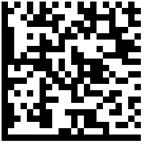
Augmented Realities
A little bit on digital marks, I selected a variety of them.
The semacode, a two dimensional code that encodes a URL. The picture (left) is the semacode of architectradure. Thank you Michael Surtees for the link! This tag embed the URL address of my blog, that can be read by your cell phone and send you to its page. I guess it avoids typing in the URL and you can rapidly go through a series of web sites using the respective tags.
It is especially useful for combining physical space to digital content. The Semacode's Software Development Kit has is developed for ubiquitous computing by creating visual tags for objects and contexts, and read them using a mobile camera phone. The physical Wikipedia called Semapedia, created by Alexis Rondeau and Stan Wiechers, allows you to add place tags on places and things to link them to the relevant Wikipedia articles.
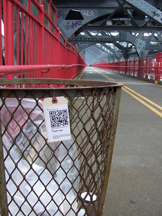 [images: trash can with a wikipedia tag] Semacode technical paper.
[images: trash can with a wikipedia tag] Semacode technical paper.
Urban Tapestries allows public mapping and sharing by combining mobile and internet technologies with geographic information systems. This system was linked to Natalie Jeremijenko's famous feral robots -open source robots for investigating contaminated urban sites- and called Robotic Feral Public Authoring: "Adding the sensor readings to online mapping tools, such as Urban Tapestries, suddenly brings the relationships between environment and home vividly to life. It enables people to feel they can learn about their environment and have the evidence to do something about it"
Yellow Arrow allows a community to tag places using arrows. You can post a message using the arrow and anyone could retrieve it using their cell phone. Another method to link digital content to a physical place. The community of yellow arrow is quite big. Their blog.
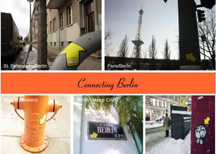
Elens allows anyone to create talking landmarks. Developed by the MIT Media Lab it allows anyone to tag a place by adding a sticker on a physical location, sticker that can later be scanned by a cell phone, in this case the Motorola A1000.
M-views developed at the MIT media lab in the interactive cinema group -media fabrics- with Glorianna Davenport, explores the "ideas, methods, and culture of mobile cinema, which is experienced in temporal and spatial narrative segments that can be delivered on context-aware mobile devices."
In 2002, I researched with Glorianna Davenport on technologies to allow digital information to communicate with the physical space. I worked on Passing Glances a system that enables users to create ambient urban interludes through the use of SMS text messages. Associated graphics and storytelling were projected in the urban space.
CHI'04 paper
Enarrative5 2003 paper
With these tags, the physical space is tagged to the digital space. One can think the other way around and tag the virtual space with physical content. That is what Josh Lifton told me he was working on the other day. Josh created a plug sensor/actuator network, called the dual reality lab, that links the MIT Media Laboratory space to a virtual lab space in the Second Life online virtual world.
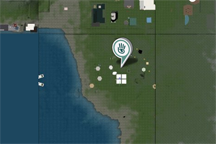
[left: Location of the MIT Media Laboratory in Second Life] More info technical about the plug. [blogged by Cati Vaucell on Architectradure]
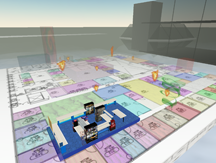
["Dual reality" is the concept of maintaining two worlds, one virtual and one real, that reflect, influence, and merge into each other by means of deeply embedded sensor/actuator networks. Both the real and virtual components of a dual reality are complete unto themselves, but are enriched by their mutual interaction. The dual reality Media Lab is an example of such a dual reality, as enabled the Plug sensor/actuator network that links our actual lab space to a virtual lab space in the Second Life online virtual world.]
Posted by jo at March 13, 2007 01:30 PM
